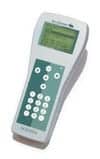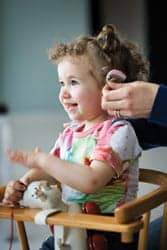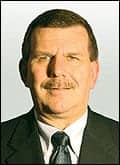Screening and fitting newborns with hearing loss
When a teenager doesn’t listen to his parents, it’s considered normal—and should be. Teenagers rebel and must often be taught the difference between hearing and listening. When a newborn doesn’t listen, it can also be considered normal—but it shouldn’t be. The inability to hear can impede child development if not treated early.
Children begin to learn speech and language in the first 6 months of life. Those who don’t are more likely to be held back, drop out of school, and fail to earn high school diplomas, according to the American Speech-Language-Hearing Association (ASHA). Several studies point to an incidence of hearing loss among newborns of between 1 and 3 in 1,000, and the National Institutes of Health (NIH) suggests hearing loss is the most common developmental abnormality present at birth.
Despite its frequency, however, newborn hearing loss has proved to be an elusive diagnosis, primarily because few were looking for it. In 1993, the National Conference of State Legislatures found that fewer than 5% of all infants were screened for hearing loss before hospital discharge. Today, thanks to awareness campaigns and government leadership, that figure has risen to 65%, with the more established programs screening 95% of their newborns before discharge.
Early screening identifies only that there is a problem. Methods suggested by ASHA guidelines include measurement of otoacoustic emissions (OAE) and auditory brainstem response (ABR). The specific diagnosis and treatment are determined through follow-up. The problem may be temporary, such as birthing fluid in the ear, or permanent, indicating a need for treatment ranging from signing to hearing aids or cochlear implants.
Whatever treatment is prescribed should be determined by the time the child has reached 6 months of age. Children who receive early intervention often function at the level of their peers by the time they enter school, producing better outcomes.
Too Young to Say “What?“

|
| GN Otometrics offers AccuScreen for infant hearing screening. With three types of technologies: TEOAE, DPOAE, and ABR. |
A newborn is not able to tell a parent or physician that he or she can’t hear, so it’s up to parents and physicians to find out themselves. The American Speech-Language-Hearing Association (ASHA) guidelines suggest two screening methods to accomplish this: otoacoustic emissions (OAE) and auditory brainstem response (ABR) tests. GN Otometrics, Denmark, is one of several companies that offers tools to complete both these physiologic exams.
The AccuScreen OAE/ABR Screener is designed to provide any combination of standard infant hearing screening technologies, including TEOAE, DPOAE, and ABR. The handheld device offers an ear coupler and a choice of 35 dB, 40 dB, and 45 dB stimulus testing. Results are “pass” or “refer” and delivered within 10 seconds for TEOAE and 90 seconds for ABR. According to the company, false “refers” are kept to a minimum: AccuScreen has an OAE specificity of better than 96%, with a referral rate of maximum 4%, and an ABR specificity of 98% and referral rate of less than 2%.
The Capella Cochlear Emissions Analyzer also performs echo-screen TEOAE screening, as well as three types of OAEs (distortion product, transient evoked, and spontaneous), and tympanometry. The combination makes it suitable for both screening and follow-up testing. The PC-based system is portable and modular.
The CHARTR EP Auditory Evoked Potential System measures ABR, and features a pediatric system called PediABR. It includes built-in protocols for infant screening, bone-conducted ABRs, and tone-burst evoked thresholds. In addition, the PediGram feature plots tone-burst threshold information on a graph similar to an audiogram.
WHY SCREEN?
A 2001 NIH-funded study found that children who are screened and enrolled in a treatment program by 6 months of age scored significantly higher in language skills than children whose hearing loss was identified after 6 months. And research on costs suggests that early treatment using a cochlear implant can save $30,000 to $200,000 in special education costs through graduation from high school due to successful mainstreaming.
But early intervention cannot be implemented without knowledge of the problem—hence, the push for newborn screening programs. ASHA estimates that without such programs the average age of detection of significant hearing loss would be 14 months, far outside the 6-month window needed to maximize development. In recognition of these benefits of newborn screening, all but five states have enacted legislation or voluntary compliance programs that screen 95% of newborns.
An early hearing and detection intervention (EDHI) program should feature three components: newborn hearing screening, audiological diagnosis, and early intervention. Education, both for the child and the parents, is key throughout the process. Many companies develop education-related materials in addition to screening and/or intervention products to inform hearing impaired children and their families.
SCREENING AND COMPREHENSIVE CARE
Education is key to completing the screening procedure accurately. The initial screening identifies a permanent or fluctuating sensorineural hearing loss or one due to a conduction problem, but not the source. Rescreening and follow-up are needed to correctly diagnose a child and determine appropriate treatment. “All hearing screens determine whether you need to go for further testing,” says Wendy Crumley, MS, product manager/audiologist with GN Otometrics.
“Basically, the screening is sort of a cursory screening,” concurs Thomas A. Powers, PhD, vice president audiology and professional relations for Siemens Hearing Instruments, Piscataway, NJ. “Newborns can’t raise their hands, so we look for a [physiological] reaction and measure it as pass/fail,” says Powers.
There are primarily two types of screening: OAE and ABR tests. The OAE tests identify if the ear is properly responding to sound by measuring the energy-generated sounds produced by the outer hair cells. ASHA notes that this test will determine those with a hearing loss greater than 25 dB to 30 dB and can identify blockage in the outer ear canal, middle-ear fluid, or damage to outer hair cells. ABR assesses the auditory pathway from the external ear to the lower brainstem by measuring electrical activity. This test can detect damage to the cochlea, auditory nerve, and auditory pathways in the brainstem. The sensitivity and specificity of these tests have been shown to be 84% and 90%, respectively; in combination, they yield fewer than 1% false positives (ie, normal-hearing babies diagnosed as possibly having a hearing loss).
-
- Wendy Crumley, MS, product manager/audiologist with GN Otometrics, Denmark.
In newborn hearing screening programs, these tests may be administered by audiologists, nurses, or technicians— often the latter in larger facilities. “If hospital audiologists were to be responsible for screening, they could potentially spend all of their hours performing screens, which would be an inefficient use of time,” Crumley says. Whoever performs the test, however, must be properly trained, and experience can produce better results. “There is a learning curve to OAEs, so if I screen 10 babies a day, I’ll be much better than if I screen one every 3 months,” Crumley says.
Another challenge is timing. Babies should generally not be screened before 11 hours after birth to permit the ear time to dry out, notes Crumley, but they are typically released from the hospital within 48 hours, making for a short time period. “You can run out of time trying to get all the babies screened before they leave the hospital,” Crumley says.
An even bigger challenge is follow-up. A baby who fails the first screening should be brought back for additional screening to confirm the problem, develop a diagnosis, and administer treatment. “We don’t have a lot of good documentation or databases put into place to identify which kids need follow-up,” Crumley says. The trick is to make parents understand the importance of the rescreen without causing undue worry. Many babies—about 80% according to Crumley—will pass the second screening.
HEARING HABILITATION
Initial screening failure can sometimes be attributed to immaturity or birthing debris in the ear canal. These infants will often pass the rescreen; those who do not will require further investigation. Causes can range from fluid in the ear to complications from prematurity to congenital defects. Further testing, including diagnostic-level ABR and OAE, will be done. Conductive hearing loss patients will likely see an ENT, while those with sensory loss will be referred to programs according to the parents’ wishes, including amplification or cochlear implants.
“The decision often depends on whether the parents are hearing or deaf. Some will choose hearing aids, others sign language, but often this early decision guides the child’s future path,” Crumley says. Only if the child’s progress is impeded will parents consider switching the method. Either way, intervention begins early.
“Children can be fitted for hearing instruments at 4 to 8 weeks,” Powers says. “It can be a challenge, but the earlier they are exposed to sound the more chance they have for normal language development.”
“For younger children, the BTE device is the style of choice,” says Maureen Doty-Tomasula, product marketing manager for Oticon Pediatrics, Somerset, NJ. BTE devices provide more flexibility with growth and the ability to adjust settings and activate features as the child gets older. “Ears grow very quickly in the first years, and earmolds are much easier to replace than custom ear shells,” she says.
The specific device will need to match the degree of hearing loss, but because many instruments provide a wide fitting range, the device can often accommodate some changes in the child’s hearing. As a child grows up, technologies such as FM compatibility, directional microphones, and telecoils may become even more advantageous. Younger children benefit from features such as tamper-resistant battery doors, smaller ear hooks, and retention devices.
“The type of environment the child is in will determine which features are necessary, but certainly the latest noise reduction, directional microphones, and signal processing are some things we would want for younger and older children,” Powers says.
FOLLOWING UP
Children with hearing problems are often seen every 3 to 6 months. “We want to make sure that hearing status has not changed,” Crumley says. Even some children who pass their initial screenings should be rescreened; this is particularly true for those with cytomegalovirus who can exhibit late-onset of hearing loss.
Children with hearing instruments need to be refitted as they grow. “With babies, you can make new earmolds almost monthly,” Crumley says. And because they cannot yet talk, the added observation permits the audiologist to gather more information about how the hearing instrument is working.
Once the child is 5 years old, visits may be reduced to once a year. The instruments themselves may be replaced every 3 to 5 years. “Children’s needs can change in just 2 to 3 years, and with their high activity levels, their hearing aids log a lot of hours in all kinds of environments,” Doty-Tomasula says. Even if the child is extremely responsible, hearing aids should still be considered for replacement every 3 to 5 years. “Technology has been advancing faster, with greater potential benefits to warrant looking at new devices in that time frame,” she says.
Because the child is so young, parents play a key role in managing treatment, including instrument care. The audiologist often guides them in decision making, and the information can be as overwhelming to present as it is to absorb. Consequently, many manufacturers are now producing support materials in addition to hearing products. This early intervention can help to assure normal childhood development—which means that parents of hearing impaired children will still have to teach their teenagers the difference between hearing and listening.
Renee Diiulio is a contributing editor for Hearing Products Report. For more information, contact [email protected].
Small Solutions for Small Ears

|
| Maureen Doty-Tomasula, MA, product marketing manager with Oticon Pediatrics. |
The most important thing about the hearing aid is that it fits—the patient’s hearing loss, lifestyle, and ears. But little ears are not at a loss for fit: many manufacturers offer pediatric lines or models that suit infant and child needs, including Oticon and Siemens.
Oticon features a pediatric instrument in most of its lines. One of the most advanced is Safran, a BTE with AI-controlled automatic features to optimize speech and audibility, reduce disturbance from noise, provide more access to speech, FM compatibility, DSL v5.0 rationale to ensure appropriate settings, directionality, and a data logging function that confirms instrument performance and helps understand the child’s needs.
“Safran has a very wide bandwidth, which is important to provide access to a wide range of speech sounds,” says Maureen Doty-Tomasula, MA, product marketing manager with Oticon Pediatrics. Other pediatric aids include pediatric ear hooks and tamper resistant accessories, which are available on all pediatric models. It also features a power BTE option.

|
| Pediatric hearing aids, like this one from Oticon, are designed to grow with children, often featuring technologies that can be enabled and disabled as the child ages and needs change. |
The SUMO DM is the company’s smallest superpower BTE and is designed for children with severe to profound hearing loss. It offers FM compatibility, eight channels for fitting flexibility and precise frequency shaping, feedback cancellation with no gain reduction, robustness, and child-friendly design and controls. “It also features a light on the shell to help parents know where the volume control should be set and whether the aid is actually on,” says Doty-Tomasula.
Tego and Tego Pro provide a more economical solution and offer increased bandwidth, flexible frequency response shaping, advanced automatics features (such as adaptive directionality), FM compatibility, and a power BTE option. “The Tego has features that can be disabled for young children and activated as their needs change. And Tego’s midrange pricing is important for many families,” says Doty-Tomasula. Like all Oticon BTE models, Tego also comes in a range of colors, permitting the child to have some input. “Picking a color gives children a say in their instruments,” says Doty-Tomasula who equates it to selecting a pair of eyeglass frames.
Siemens Hearing Instruments also has a complete range of pediatric products. Its Centra P BTE is designed for moderate to severe hearing loss. It features SoundSmoothing, DataLearning (recorded usage data), and wireless technologiesm, as well as audio input and FM compatibility, telecoil, volume control with learning function, lockable battery compartment, push button and alert tone for program changes, and four individual hearing programs for the microphone, audio shoe, and telecoil mode.

|
| Siemens Hearing Instruments offers Centra™, a hearing aid that automatically adjusts to a user’s preferences in a variety of different environments. |
The company’s Acuris line is designed to work with e2e wireless technology for true binaural hearing; the technology is also available on other models. The P BTE model features speech and noise management, feedback cancellation, volume control, on/off control, program change button, telecoil, audio input, and battery door lock.

|
| Thomas A. Powers, PhD, Siemens vice-president of audiology and professional relations. |
The Artis 2 P is designed to maximize hearing, speech development, and learning with specific advances and pediatric features for children with mild to moderately severe hearing loss. The Artis 2 SP is for those with profound to severe loss. FM coupling, DataLearning, ePocket remote control, flexible programming (12 independent frequency and gain channels), and feature enabling/disabling permit caregivers to meet a child’s changing needs with one device. Nanocoating and colors contribute child-friendly robustness and design.
Cielo, Intuis, and Phoenix models—Siemens’ value and basic digital hearing lines—round out the company’s pediatric offerings. All pediatric models offer audio input and FM compatibility, as well as about 16 color choices. “Color shells make them easier to find when they are dropped,” notes Thomas A. Powers, PhD, Siemens vice-president of audiology and professional relations.






